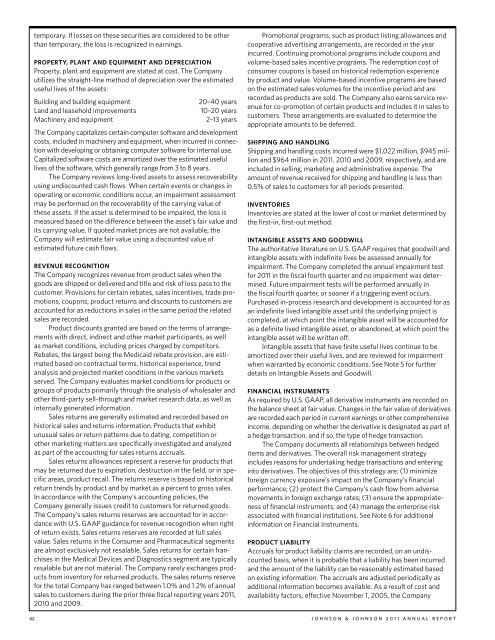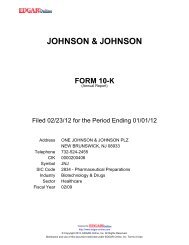ANNUAL REPORt 2011 - Investor Relations - Johnson & Johnson
ANNUAL REPORt 2011 - Investor Relations - Johnson & Johnson
ANNUAL REPORt 2011 - Investor Relations - Johnson & Johnson
You also want an ePaper? Increase the reach of your titles
YUMPU automatically turns print PDFs into web optimized ePapers that Google loves.
temporary. If losses on these securities are considered to be other<br />
than temporary, the loss is recognized in earnings.<br />
PROPERTY, PLANT AND EQUIPMENT AND DEPRECIATION<br />
Property, plant and equipment are stated at cost. The Company<br />
utilizes the straight-line method of depreciation over the estimated<br />
useful lives of the assets:<br />
Building and building equipment 20–40 years<br />
Land and leasehold improvements 10–20 years<br />
Machinery and equipment 2–13 years<br />
The Company capitalizes certain computer software and development<br />
costs, included in machinery and equipment, when incurred in connection<br />
with developing or obtaining computer software for internal use.<br />
Capitalized software costs are amortized over the estimated useful<br />
lives of the software, which generally range from 3 to 8 years.<br />
The Company reviews long-lived assets to assess recoverability<br />
using undiscounted cash flows. When certain events or changes in<br />
operating or economic conditions occur, an impairment assessment<br />
may be performed on the recoverability of the carrying value of<br />
these assets. If the asset is determined to be impaired, the loss is<br />
measured based on the difference between the asset’s fair value and<br />
its carrying value. If quoted market prices are not available, the<br />
Company will estimate fair value using a discounted value of<br />
estimated future cash flows.<br />
REVENUE RECOGNITION<br />
The Company recognizes revenue from product sales when the<br />
goods are shipped or delivered and title and risk of loss pass to the<br />
customer. Provisions for certain rebates, sales incentives, trade promotions,<br />
coupons, product returns and discounts to customers are<br />
accounted for as reductions in sales in the same period the related<br />
sales are recorded.<br />
Product discounts granted are based on the terms of arrangements<br />
with direct, indirect and other market participants, as well<br />
as market conditions, including prices charged by competitors.<br />
Rebates, the largest being the Medicaid rebate provision, are estimated<br />
based on contractual terms, historical experience, trend<br />
analysis and projected market conditions in the various markets<br />
served. The Company evaluates market conditions for products or<br />
groups of products primarily through the analysis of wholesaler and<br />
other third-party sell-through and market research data, as well as<br />
internally generated information.<br />
Sales returns are generally estimated and recorded based on<br />
historical sales and returns information. Products that exhibit<br />
unusual sales or return patterns due to dating, competition or<br />
other marketing matters are specifically investigated and analyzed<br />
as part of the accounting for sales returns accruals.<br />
Sales returns allowances represent a reserve for products that<br />
may be returned due to expiration, destruction in the field, or in specific<br />
areas, product recall. The returns reserve is based on historical<br />
return trends by product and by market as a percent to gross sales.<br />
In accordance with the Company’s accounting policies, the<br />
Company generally issues credit to customers for returned goods.<br />
The Company’s sales returns reserves are accounted for in accordance<br />
with U.S. GAAP guidance for revenue recognition when right<br />
of return exists. Sales returns reserves are recorded at full sales<br />
value. Sales returns in the Consumer and Pharmaceutical segments<br />
are almost exclusively not resalable. Sales returns for certain franchises<br />
in the Medical Devices and Diagnostics segment are typically<br />
resalable but are not material. The Company rarely exchanges products<br />
from inventory for returned products. The sales returns reserve<br />
for the total Company has ranged between 1.0% and 1.2% of annual<br />
sales to customers during the prior three fiscal reporting years <strong>2011</strong>,<br />
2010 and 2009.<br />
Promotional programs, such as product listing allowances and<br />
cooperative advertising arrangements, are recorded in the year<br />
incurred. Continuing promotional programs include coupons and<br />
volume-based sales incentive programs. The redemption cost of<br />
consumer coupons is based on historical redemption experience<br />
by product and value. Volume-based incentive programs are based<br />
on the estimated sales volumes for the incentive period and are<br />
recorded as products are sold. The Company also earns service revenue<br />
for co-promotion of certain products and includes it in sales to<br />
customers. These arrangements are evaluated to determine the<br />
appropriate amounts to be deferred.<br />
SHIPPING AND HANDLING<br />
Shipping and handling costs incurred were $1,022 million, $945 million<br />
and $964 million in <strong>2011</strong>, 2010 and 2009, respectively, and are<br />
included in selling, marketing and administrative expense. The<br />
amount of revenue received for shipping and handling is less than<br />
0.5% of sales to customers for all periods presented.<br />
INVENTORIES<br />
Inventories are stated at the lower of cost or market determined by<br />
the first-in, first-out method.<br />
INTANGIBLE ASSETS AND GOODWILL<br />
The authoritative literature on U.S. GAAP requires that goodwill and<br />
intangible assets with indefinite lives be assessed annually for<br />
impairment. The Company completed the annual impairment test<br />
for <strong>2011</strong> in the fiscal fourth quarter and no impairment was determined.<br />
Future impairment tests will be performed annually in<br />
the fiscal fourth quarter, or sooner if a triggering event occurs.<br />
Purchased in-process research and development is accounted for as<br />
an indefinite lived intangible asset until the underlying project is<br />
completed, at which point the intangible asset will be accounted for<br />
as a definite lived intangible asset, or abandoned, at which point the<br />
intangible asset will be written off.<br />
Intangible assets that have finite useful lives continue to be<br />
amortized over their useful lives, and are reviewed for impairment<br />
when warranted by economic conditions. See Note 5 for further<br />
details on Intangible Assets and Goodwill.<br />
FINANCIAL INSTRUMENTS<br />
As required by U.S. GAAP, all derivative instruments are recorded on<br />
the balance sheet at fair value. Changes in the fair value of derivatives<br />
are recorded each period in current earnings or other comprehensive<br />
income, depending on whether the derivative is designated as part of<br />
a hedge transaction, and if so, the type of hedge transaction.<br />
The Company documents all relationships between hedged<br />
items and derivatives. The overall risk management strategy<br />
includes reasons for undertaking hedge transactions and entering<br />
into derivatives. The objectives of this strategy are: (1) minimize<br />
foreign currency exposure’s impact on the Company’s financial<br />
performance; (2) protect the Company’s cash flow from adverse<br />
movements in foreign exchange rates; (3) ensure the appropriateness<br />
of financial instruments; and (4) manage the enterprise risk<br />
associated with financial institutions. See Note 6 for additional<br />
information on Financial Instruments.<br />
PRODUCT LIABILITY<br />
Accruals for product liability claims are recorded, on an undiscounted<br />
basis, when it is probable that a liability has been incurred<br />
and the amount of the liability can be reasonably estimated based<br />
on existing information. The accruals are adjusted periodically as<br />
additional information becomes available. As a result of cost and<br />
availability factors, effective November 1, 2005, the Company<br />
42 JOHNSON & JOHNSON <strong>2011</strong> <strong>ANNUAL</strong> REPORT




